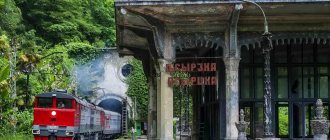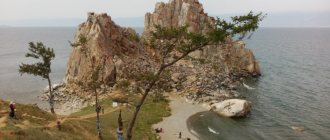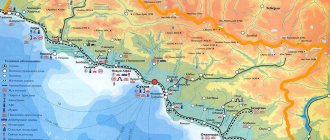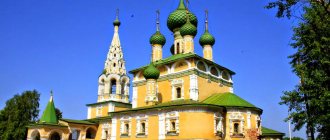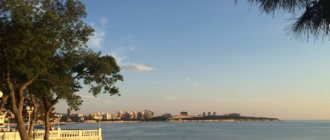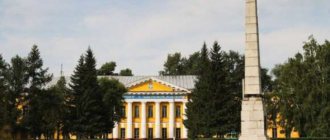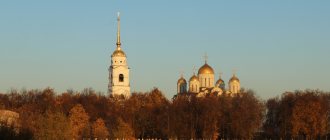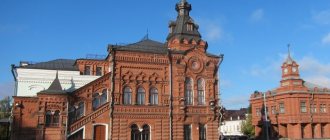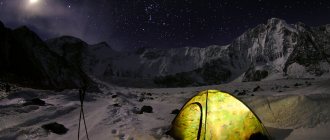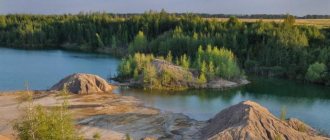In this article we will tell you in detail how to get to Abkhazia and what you can see there in each of the cities. We will also write about housing, food, medicine and safety! In general, we will answer all the most frequently asked questions!
Attention! Each place was personally researched by the editorial staff (many of whom are true fans of Abkhazia)!
How to get to Abkhazia
Let's look at ways to get to Abkhazia from Sochi without a car.
- Bus. You need to get to the stops “Cossack Market” (57, 100, 125, 117), “Checkpoint Psou” (125P, 173), there cross the pedestrian border between Russia and Abkhazia and transfer to a minibus to the city you need (they are signed in large letters ), and the drivers won’t let you “miss.” It is impossible to get lost on this path: move along with the general flow. Minibus cost: Gagra, Pitsunda – 100 rubles, Sukhum – 200 rubles, Ochamchira – 250 rubles.
- Electric train. The Adler-Sukhum-Adler train runs from Adler railway station twice a day. The fare is 140 rubles to Gagra, 200 rubles. to Sukhum, travel time - 4 hours. The advantage of traveling by train or train is that there is no need to get out of the carriage and stand in lines at customs control.
- Train. There are several long-distance trains: Moscow-Sukhum, St. Petersburg-Sukhum, as well as several trailer cars from other Russian cities.
Tsandripsh
Abkhazia is a state of contrasts. Here you can find both the quietest and wildest areas, and very noisy and crowded ones. If the goal is a relaxing, family vacation, then it is better to relax in Tsandripsha. This is a small village, located only 5 km from the border with Russia. There are few tourists, the beaches are sandy and pebble, the sea is warm, the nature is beautiful.
The village is famous for its white cliffs, the only ones on the Black Sea coast.
There is little entertainment here. This mainly includes river rafting, excursions to historical places, water attractions, horseback riding, and hiking. There are not many hotels - 6-7. The private sector is more developed. Some rooms are rented next door to the owners, so it is better to clarify this point in advance. The range of prices for accommodation in the private sector is quite wide - from 250 to 4000 rubles.
A 10-day tour for two with accommodation at the SPA Hotel “Napra” during peak season will cost 45 thousand rubles. The price includes a buffet breakfast. The hotel is equipped with a Russian bath, hammam, and laundry. There are grills and barbecues. Park-hotel "Abkhazia" is suitable for a family. A “Lux” room for 3 people will cost only 2,500 rubles. per day.
Abkhazia: where is the best place to relax depends on the purpose of the trip: treatment, entertainment or simple sunbathing on the beach
The hotel has a children's playground, children's menu, swimming pool, paid babysitting service, and free transfer from the Russian border. The disadvantages include poorly developed infrastructure, lack of children's entertainment and a small selection of hotels.
How to cross the border with Abkhazia
During the “high season”, crossing the border between Russia and Abkhazia can take up to several hours due to the large number of tourists. Stock up on drinking water and hats. At night and early in the morning the flow of tourists is much less.
Citizens of Russia only need to have a Russian or foreign passport. There is a visa-free regime between Abkhazia and Russia.
A child under 14 years of age must have a birth certificate. If the child is accompanied by one parent and the parents are not married, then the permission of the second parent for the child to leave is not required.
If a child travels without parents, then the person accompanying him is obliged to provide notarized consent of the parents for the child to travel abroad.
Advice: do not be rude to customs officers, fulfill their requests without contradicting them, do not try to joke - this is out of place here and can lead to unpleasant consequences.
general information
Abkhazia occupies an area of slightly less than nine thousand square kilometers. The country is located in a most picturesque place - it is surrounded by the Caucasus Mountains and the beautiful Black Sea coast. The republic is washed on both sides by the Psou and Ingur rivers. The country has common borders with Russia and Georgia.
The population of the country is not very large - approximately 243 thousand people live permanently on the territory of Abkhazia. Abkhazia is considered a multinational republic - on the streets you can meet not only Abkhazians, but also Georgians, Russians, Armenians, Ukrainians, Jews, Estonians and representatives of other nationalities.
Despite this fact, the local people of Abkhazia are known for their hospitality and friendliness. They will always help tourists with advice, tell interesting facts about the life and traditions of the country, and some will even feed them masterpieces of local cuisine.
What to see in Gagra with children?
Abaata Fortress. Located within the city, admission is free. It was built around the 5th-6th centuries to protect the approaches to the city, but, of course, it was not preserved in its original form. The fortress has been almost completely restored; during the restoration, only a few original ancient elements remained: fragments of masonry, loopholes. On the territory of the fortress there is the Church of the Blessed Virgin Mary.
Mount Mamdzyshkha. The mountain offers a magnificent view of the coast of Abkhazia, including Cape Pitsunda. You can get to the top by car or taxi; the height of the peak is 1870 m. As you climb, pay attention to the change in the vegetation landscape: trees are replaced by grass. Be sure to bring windbreakers with you.
Gagra colonnade. A colonnade that no tourist in Abkhazia will ever pass by. She became famous thanks to footage from the film “Winter Evening in Gagra.” Now in the evenings the colonnade is beautifully illuminated. But it’s unlikely that you’ll be able to take a beautiful photo here: the area in front of the colonnade is completely lined with cars. But you still need to visit here and at least try tap dancing! And also drink delicious oriental coffee!
Restaurant Gagripsh. It has been a faithful symbol of the city for more than a century. The Gagripsh restaurant was purchased by the founder of the Gagra resort, Prince A.P. Oldenburgsky at the beginning of the 20th century at the World Exhibition in Paris. The wooden house with the clock was delivered to Abkhazia disassembled in 1902 and reassembled without a single nail. If you are lucky and the restaurant is not closed to serve a magnificent Abkhaz wedding, then here you can touch the legend, admire the magnificent view from the balcony (which, by the way, Chekhov, Gorky and Chaliapin admired), and also try a real Abkhaz khachapur boat.
Gagra water park. Quite a large open-air water park with many pools and water attractions. Cost: adult ticket 1000 rubles, children’s ticket – 800 rubles. Children under 3 years old are free.
For lovers of stalker tourism: we recommend visiting the castle of the city’s founder, the Prince of Oldenburg. It is visible from almost every point of Gagra and is located on the mountainside. The building is incredibly beautiful - this is obvious, even despite the fact that the building is in absolute ruin. You can't go inside, just look from the outside. Although some especially brave “stalkers” managed to bypass the guard and have a super photo shoot inside the castle. And by the way! Of course, there is a ghost living in it!
From Gagra it is convenient to get to such attractions of Abkhazia as Lake Ritsa and the Auadhara spring (located above Ritsa). Lake Ritsa , although it is considered the most “pop” attraction of Abkhazia, it cannot be ignored. It's really incredibly beautiful there! But we don’t recommend going to Auadhara with children: the road is very bad and winding. At the top you will find a famous spring with healing mineral water, as well as alpine meadows.
Sights and interesting excursions for children
Abkhazia is very rich in historical monuments, natural reserves, cultural and religious heritage. There are also many places in the country that will delight children and not let them get bored. It is unlikely that you will be able to see them all in one vacation, but you can visit the main ones:
- A nursery with monkeys in Sukhum will bring a lot of pleasure to kids and will touch parents. On the territory of the scientific reserve there are more than three thousand species of monkeys, each of which can be fed with special food sold at the entrance to the nursery.
Nursery with monkeys in Sukhumi - Botanical Park - located near the monkey nursery and will surprise every member of the family. Here you can find more than five thousand species of various plants, many of them exotic.
- Lake Ritsa is one of the main attractions of Abkhazia, a must-see place. On the way to the lake you can admire the Caucasus Mountains, small rivers and the most beautiful nature of Abkhazia. The guide will tell you several interesting legends and myths associated with Lake Ritsa, which will certainly interest the little tourist.
- The largest cave in Abkhazia, New Athos, consists of 11 halls, almost all of which are open to tourists. Also on the territory of the cave there are two beautiful lakes that will delight you with their mystery. Children will definitely be imbued with the mystical atmosphere and will remember this excursion for a long time.
- Alpine meadows in the Caucasus Mountains are a picturesque place for quiet relaxation and admiring nature. The road to them is quite long, however, children will enjoy the journey over bumps and mountain slopes, and the view of the meadows will evoke the most vivid emotions among tourists of all ages.
Alpine meadows
With an inquisitive older child, you can visit the historical and cultural places of Abkhazia - the Sukhumi fortress, the Annunciation Cathedral, the ancient city of Pitiunt, the Gagra and Ilor fortresses. You can also visit the local history museum in Sukhumi, where guides will introduce you to the traditions and history of the republic.
There are a lot of places in Abkhazia that will be interesting to children of different ages and will not cause boredom or tears. Beautiful views, mysterious legends, exotic plants and animals - every child will be delighted with such a pastime.
What to see in Pitsunda?
Patriarchal Cathedral of St. Andrew the First-Called 10th century
Touch the antiquity: this temple is unique. Ancient frescoes and a tomb with the tombs of St. Andrew the First-Called and Simon the Canaanite have been preserved here. The church has housed a German organ since 1975, and organ music concerts are regularly held. You can't miss this! The International Classical Music Festival in Pitsunda takes place annually from September 9 to 11.
Honestly, we can’t recommend any more interesting places in Pitsunda, but you should definitely take a walk along the embankment, there you will find a relict Pitsunda pine (hug a tree - there are so few of them left!) and interesting sculptures.
From Pitsunda it is convenient to visit such sights of Abkhazia as Lake Ritsa, the village of Myussera (where Stalin’s dacha and Gorbachev’s palace are located), the village of Lykhny (an ancient village where you can visit the ruins of an ancient temple of the 6th century, an Abkhaz tea factory).
Route
The line is a single track and electrified narrow gauge railway. It begins at the entrance to the caves, not far from the Psircha station of the Abkhazian railway. From the Entrance Gate station, it reaches two cave halls: Apsney Hall and Anacopa Hall. Apsny station is designed to guide tourists at the beginning of the cave tour, and Anakop returns them to the entrance gate at the end of the tour. The line has a depot directly in front of the entrance station and a service tunnel between it and Apsny.
What to see in New Athos
In our opinion, this is the most “fertile” city for a holiday in Abkhazia, since it combines many attractions. This is a monastery, a cave, waterfalls, a fortress... First things first.
New Athos karst cave
Paradise for young speleologists! Children absolutely love this place! Here they will ride an underground train, see stalactites and stalagmites, and hear plenty of legends. Dress warmly. Cost of visiting: 500 rubles, children under 8 years old – free. During the winter, the cave has many days off - Monday, Tuesday and Friday.
And what a market is located on the square in front of the cave! We highly recommend it to hunters of souvenirs and authentic items!
New Athos Monastery
The domes of the monastery are visible from afar. To climb to the monastery (as to any truly holy place) you need to climb a steep mountain. It's worth it: the site offers a magnificent view. The building of the monastery is very shabby, but no less majestic (the monastery was built in the Byzantine style).
Cell of Simon the Canaanite
You need to get to it along a winding path, follow the signs. You will find yourself in a real grotto of the holy apostle.
Anakopia fortress
And we climb up again! The fortress is located on Mount Anakopia, it was restored from ruins that date back to the 7th century. The climb to the top is quite difficult and is not recommended for small children.
New Athos waterfall
An artificial, but very picturesque waterfall is located not far from the cave and the monastery - it is very difficult to pass by. There are also many different joys for a tourist: photos with animals, Abkhaz delicacies, souvenirs... Walking further from the waterfall, you will find yourself at the picturesque Lake Psyrtskha and an abandoned railway station.
Swan Lake
A fabulous place: almost tame black and white swans live here; you can feed them from the shore or from the bridge. Or you can also rent a boat, then the fabulousness of the moment will simply go off scale! There is a restaurant on the lake that serves incredibly delicious kharcho soup.
We recommend visiting the Guada restaurant, and if you have already tried all the Abkhaz cuisine, then order pizza and white wine here. You will not regret!
From New Athos you can go to Kamany, where there is a very beautiful monastery that once kept the relics of John Chrysostom, and now many other shrines. Also in Kamany you can swim in the spring of the Holy Great Martyr Basilisk (be sure to read his story first) and look in the spring for magic stones sprinkled with his blood. Well, get inspired by the history of the construction of a wooden temple (it was built by the father of a seriously ill girl who was cured of her illness after visiting these holy places). You definitely need to go from Athos to Sukhum (half an hour by any transport).
Gudauta
The charming seaside resort was once famous for its military sanatoriums, but is now not so popular with tourists. In 2018, the city continues to actively develop and build up, so in just a few 3-4 years the flow of people wanting to soak up the sun on the pristine beaches will increase noticeably.
The beaches, as a rule, are pebble with a sandy bottom and easy entry into the sea, equipped with sun loungers and umbrellas, and some offer entertainment: banana rides, swimming pools with water slides, boat trips.
The infrastructure is still weak, although there are bars, cafes, and restaurants. Therefore, if you are aiming to visit water parks, amusement parks and popular tourist spots, then you should choose larger resorts. If your priority is an educational and relaxing vacation, then think about Gudauta.
Accommodation here is rather economy class; large hotels are just being built, but among inexpensive options you can find excellent accommodation that will satisfy the wishes of all family members.
Pearl 3*
1 of 8
A small private guest house with its own access to the sea is the best place for a relaxing holiday with small children. There are not many rooms - about 20, comfortably decorated and with everything you need for your stay. Children under 5 years old stay free.
There is a minimum staff - the hostess is in charge of everything, but nevertheless, the cleanliness and neatness will be the envy of many five-star chain hotels. The standard package includes two meals a day (breakfast + dinner), but lunch can also be ordered separately. The cuisine is simple, homemade, but some note that the dishes are too spicy or their quantity is small. As for feeding children, the chef is ready to make adjustments at the request of guests, but in general the choice of dishes allows you to feed a child without difficulty. There are grocery stores nearby where you can also buy baby food.
There are no entertainment activities offered here, and they are not included in the overall concept. To avoid getting bored, guests take a walk to the local park, where there is a good selection of attractions for children and a cafe with live music for parents.
The hotel does not have its own beach; guests use the city beach, but the area is clean, uncrowded, and there are sun loungers and umbrellas. The hotel also offers a special mat for guests. The entrance is gentle, but with large pebbles, so you will need special shoes.
La Terrasa
1 of 8
Do you want to relax your soul and body and gain strength? Book this small hotel with confidence. The building is made in the style of a French chalet, the rooms are cozy, spacious, bright, and most importantly new and clean. Important feature: only the side rooms have air conditioning, the rest have fans.
The territory is under constant security, video cameras are working. There are terraces on the floors where you can relax in pleasant silence. There is a cafe serving dishes of national and European cuisine, as well as a cafe on the beach and a small bar. Most vacationers eat at the hotel due to the optimal prices and quality of food, which is quite suitable for feeding children. Here you can either limit yourself to breakfast or order a full meal, and guests often do just that after trying the food.
There is no entertainment on site, but you can book a trip with a professional guide.
A well-maintained beach is a couple of minutes walk away. There are free sun loungers, umbrellas, and a cafe with cool drinks and pleasant music. The location is also very good - nearby are shops, a market and an amusement park for children and adults. A transfer service from the airport or train station is available for visitors.
San Siro
1 of 14
A small budget hotel located on the 2nd line from the sea. The building is relatively new and compares favorably with its neighbors. Guests are offered spacious single and double rooms in neutral colors with all amenities. Some rooms are equipped with a balcony, but there are also common balconies with furniture and dryers on the floors.Cleaning is officially carried out every day, but in fact the maid cleans when guests ask and leave a key.
A distinctive feature is that pets are allowed here. There are no special conditions created here for children. There is no entertainment on site - it is rather a convenient place for overnight stays between trips around the country.
The boarding house does not offer any food on its own, but recommends eating in the dining room nearby. Not everyone likes the quality of the food there, and guests most often look for where to eat on their own. There are more than enough options in this part of the resort, but we recommend visiting the establishment opposite where they make amazing Ossetian pies.
To get to the beach you need to walk a little through the park. The beach is small, clean, with small pebbles, so you won’t need shoes, and walking barefoot here is even useful, as it creates the effect of an excellent massage. The approach is gentle, safe for children, and the water is crystal clear.
What to see in Sukhumi
Capital of Abkhazia. The magnificent bright and clean embankment of Mahadzhirov, buried in oleanders. A rotunda, a drama theater with a fountain, a presidential palace... There is no such splendor in any city in Abkhazia.
Botanical Garden
The greenest place in the already green Abkhazia. There is always something blooming and fragrant here. In hot weather it is always cool here under the shade of bamboo thickets or Caucasian linden. Come collect the herbarium and photograph turtles! Cost: adult – 250 rubles, children – 50 rubles.
Sukhumi monkey nursery
Let's not lie: the place is quite depressing, like all zoos. But still, it will be interesting for children to watch so many monkeys and observe their behavior in a flock. Here you gain respect for the monkeys: after all, thanks to them, vaccines against polio, typhoid, smallpox, hepatitis and other diseases were discovered in the nursery. Feed the monkeys - you can do it here! Cost: 150 rub.
Museum of Local Lore
This new and highly interactive museum will help you get to know Abkhaz history and culture better. There is a real dolmen at the entrance. The guide will tell you about it. Inside you will find a model of an Abkhazian courtyard - very cozy and life-like. You can look at it for half an hour! And of course, here you will find utensils, dishes, decorations, and Abkhaz costumes, and believe me, they will impress you. Cost: 150 rub.
Sukhumi market
The most colorful market in Abkhazia! Bundles of churchkhella and dried persimmons, towers of cheese rounds, ruins of the freshest herbs, vegetables and fruits, bags of tea, nuts and corn, barrels of adjika, colorful counters with all kinds of spices, and the smells... It's something incredible! Take with you exactly as much money as you intend to spend, otherwise you risk buying up half the market.
We recommend going a little deeper and finding stalls selling pickles. Be sure to try pickled bamboo and corn cobs (they are pickled whole), and of course, turshu (beans). Don’t pass by the fig and walnut jam – people here know how to make it and love to make it, and the prices aren’t too bad. And be sure to try the giant Greek olives!
Queen Tamara Bridge (Besletsky Bridge)
Within the city there is a unique attraction - the Queen Tamara Bridge, built in the 10th century. The bridge is legendary, and the most favorite legend, of course, is that the cement is mixed with chicken eggs. The place is very picturesque: green and quiet, here you can have a wonderful rest and have a picnic on the shore of Besletka.
eat in Sukhum at the Nartaa restaurant (which Lena Letuchaya gave five marks on all points except the toilet), at Ertsakhu (considered the best restaurant in the city), as well as at the Turkish restaurant Barista.
From Sukhum we recommend going to Chernigovka (a magnificent place: a restaurant right in a gorgeous gorge with a mountain river and waterfalls), a trout farm in Drandy (the prices are very reasonable, they won’t charge you for fishing or fishing rods, and the caught trout will be cooked for you right here or given to you fresh). The village of Kamany is also conveniently located to Sukhum.
From Sukhum you can also go to the mud springs in Kindgi, to the Otap cave (it is smaller than the New Athos cave, but very authentic and colorful!), go hiking to the mountain lake Amtkyal, and visit the temple in the village of Mokva. Oh yes, in Mokva there lives a herbalist who makes decoctions from mountain herbs for various ailments, including infertility.
Alakhadzy
The increasingly popular resort is located between Pitsunda and Gagra. This is a small village with amazingly beautiful nature and diverse wildlife. The opening view of Mount Mamdzyshkha will leave a delightful impression. The beaches are clean and free, the sea is warm, there are few tourists. Alakhadzi is suitable for lovers of a quiet country holiday.
There is practically no entertainment, except that you can go on excursions, go fishing and visit a cafe. There are taxi services in the village.
Most accommodation offers are houses or rooms in the private sector. There are prices and conditions for every taste. There is only 1 large hotel in the village - “Paradise Beach”, which includes modern rooms with good repairs and delicious food. Not suitable for families traveling with children under 2 years old. The Standard room costs 5,000 rubles. per day, all inclusive.
For tourists with children, the Santa-Sofia recreation center is suitable. A “Lux” room for 4 people will cost 2,500 rubles/day. You can also consider the cozy mini-hotel “U Albina”. The economy option costs 350-500 rubles. during peak season, luxury - from 1000 to 2500 rubles.
You can freely take economy class, since it is not very different from luxury.
Ochamchira
If Gagra is the worst nightmare of a social phobe, then Ochamchira is a piece of paradise :)
It's quiet, deserted, calm and... very boring. If you want to miss the company, come here for a week. Renting accommodation and finding delicious food is not a problem here. Swimming in the sea (at the same time on a deserted beach) is the same.
But from Ochamchira you can go to the shrines of eastern Abkhazia: Ilor (a temple shrouded in legends: the priest conducts exorcism sessions there), Bedia (the temple is not active, but in such a place that it will take your breath away), as well as Tkuarchal (in the photo below, a city for stalkers) and Gal (the closest city of Abkhazia to Georgia, here are the most delicious khinkali and the cheapest Georgian wine).
Origin of Ritsa
There is an ancient legend about the origin of this reservoir. In ancient times, on the site of the modern lake there was a valley and a river. There lived a girl named Ritsa with three brothers Edzhpsta, Atsetuka and Pshegishkha. Ritsa used this place as a pasture for her valley animals, and her brothers hunted in the high mountains during the day and returned to the valley in the evening, where they ate, sang songs and admired their sister.
One day the brothers went too far into the mountains. Ritsa decided to call them and sang loudly. The forest robbers Gega and Yupshara heard her and decided to kidnap her. Ritsa's brothers heard her cry and came to her aid. Pshegishkha threw his sword at the robbers, but he missed, and the sword flew over the river. The valley was filled with water and turned into a lake. Ritsa escaped from Yupshara’s hands, but fell into the lake. The brothers could not save her. Then Pshegishkha threw the robber Yupshara into the lake, but the water of Ritsa did not accept him and threw him over the sword, and the water carried him to the sea. Gega ran after Yupshara, but he could not save him. Out of grief, the brothers turned into mountains, and today they still stand here to protect Ritsa's resting place.
Medicine in Abkhazia
This question worries many. Everyone has heard about the famous summer “sea infection” that most vacationers in Abkhazia encounter, especially in August.
We would like to reassure you a little: in all the listed cities of Abkhazia there is an ambulance and an infectious diseases hospital. The ambulance arrives quite quickly (about half an hour); if hospitalization is required, then no documents other than a passport or certificate are needed. The policy is not valid in Abkhazia; you will be accepted without it. Help for children is provided free of charge, for adults - on a paid basis (a dropper costs about 300 rubles). After the drip, as a rule, it immediately becomes better, and the patient is sent home with some recommendations.
Symptoms of infection: nausea, vomiting, loose stools. At the first signs, you need to call an ambulance or go to the infectious diseases department yourself if you know where it is.
To prevent intestinal infection, you need to know:
The peak of “marine infection” occurs in August – the hottest month in the subtropics. Sea water warms up to a temperature that is very favorable for the development of bacteria in it. Therefore, rule number 1: avoid getting sea water into your mouth.
Be sure to wash your fruit.
Don't eat in questionable establishments (adults should be careful with local wine).
Bring Enterosgel with you from Russia - the most powerful remedy in the fight against intestinal infections.
History of construction
Since the wall was first scientifically explored at the beginning of the 19th century, many hypotheses about who built it and when were published even then. For example, the Swiss traveler Frederic Dubois de Montreux claimed that it was built by the Greeks in the last centuries BC to protect their colony of Dioscurium (which he erroneously identified near Cape Codori).
According to researcher Mikhail Ivashchenko, the wall was built by the Byzantines in the 4th century to protect their possessions and control mountain passes. He associated the name of the Kelasuri River with the Byzantine Greek kleisura (territorial unit). Several other historians supported this date, although they could not agree on the length and actual location of the wall. This structure was first depicted on a 17th-century map at the headwaters of the Galidzhza, Okum and Eris-Tskari rivers (upper left corner).
The famous Abkhaz historian and archaeologist Yuri Voronov examined the wall in 1966-1971 and suggested a new date for its construction. According to him, Levan II Dadiani of Megrelia built it between 1628 and 1653 to protect his fiefdom from the Abkhazians (although at that time the Principality of Abkhazia was a nominal vassal of Megrelia). During these investigations, loopholes for firearms were found in the wall. In addition, the scientist also relied on the works of the Georgian historian Vakhushti and the Italian missionary Archangelo Lamberti, who wrote about the wall built by the Mingrelian princes to protect against the Abkhazians.
Security issue in Abkhazia
We often come across the stereotypical idea that in Abkhazia a girl cannot walk down the street alone - she will be immediately stolen. This is wrong. Abkhazia is an original country, but not wild. Behave modestly, don’t walk around the city in a swimsuit or pareo, and no trouble will happen to you.
But theft, indeed, flourishes in Abkhazia. Don’t leave your bags unattended, don’t take a lot of money with you (although this is also difficult - after all, ATMs in Abkhazia are not so easy to find, and stores don’t accept cards). Do not leave cameras or laptops in cars.
In general, be vigilant, and you will have a wonderful holiday in Abkhazia!
Tips for tourists
- The nature of Abkhazia has retained its untouched appearance to this day! Which allows us to enjoy the incredibly clean mountain air and sea breeze.
- Yes, the resorts of Abkhazia do not have high service and 5 stars in Abkhazia will differ from 5 stars in Europe, but you should understand that the same applies to pricing policy. This small republic is just beginning to develop a modern tourism business, but that is its beauty.
- The sights that we can see here are over 2000 years old, which makes the lands of Abkhazia unique
- Mineral and mud clinics, pine groves, mountain ranges of the Caucasus mountains, clear sea will definitely bring healing effects for your entire family.
- Abkhazia is a safe and exciting country for holidays with children.
- We advise you to decide on the resort that suits you best, book a transfer or transportation in advance, decide on accommodation, and withdraw more cash to avoid interruptions in the operation of ATMs, and feel free to go on vacation to Abkhazia with the whole family!
Children's entertainment
In many cities of Abkhazia, on the embankment you can find a lot of entertainment for children of different ages:
- Riding on bananas and pills
- Boat trips
- Playgrounds
- Trampolines
- Remote control cars
- Shooting Range
- Excursion mini-trains
- Children's fishing
In addition to such entertainment, you can take excursions to the natural and architectural heritage of this country. Mountain lakes, waterfalls, gorges, hot springs, ancient fortresses, many spiritual places.
A visa-free regime allows Russian tourists, if they wish, to travel to Sochi Park (Russian Disneyland) , see the Olympic venues (detailed article on our website indicating all children's entertainment), visit the Adler Dolphinarium and other attractions of Sochi.
sightseeing flights on a hang glider will be interesting for older children and adults . You will be able to fully enjoy the beauty of Abkhaz nature from a bird's eye view.
Planning
A trip with children to any country requires thorough preparation.
What points need to be studied in advance:
- Necessary documents for crossing the border with children
- Choice of housing - proximity to the sea, quality of the premises in which children will live, accessibility to basic infrastructure facilities (pharmacy, grocery stores, banks)
- The issue of medical care in the country
- Preparing a first aid kit (essentials)
- Preparation of a list and addresses of the necessary telephone numbers (telephone and address of the apartment owner, several taxi telephone numbers, telephone number and address of the Russian Embassy in Abkhazia).
- Preparing a guidebook or printing information on the main attractions and planned excursions.
- The issue of cellular communications - in Abkhazia the easiest way is to buy a local SIM card for a month. But it’s better to buy not at tourist kiosks, but at mobile phone stores. We got 1000 rubles. for a month. At the same time, outgoing calls within Abkhazia, as well as incoming calls from Russia, were free + constant Internet.
- Entertainment for children on the plane and throughout the trip - books, small toys, drawing kits, etc.
- Money question:
- Do they accept bank cards (in Abkhazia, by the way, it is very rare where you can pay by card);
- how, if necessary, you can get money from relatives (bank transfers, western union, etc.);
- how ATMs work (at ATMs in Abkhazia you can withdraw cash using Visa, Mastercard, Maestro cards. The fee for cash withdrawal is determined by the bank that issued the card, that is, your bank).
If you have not yet chosen where you will live and want to save money when booking, we recommend using the RoomGuru service. Firstly, it contains hotels, apartments and guest houses from many different booking systems, so you won’t miss out on a worthwhile option. Secondly, you can immediately compare prices for one place in different services and book where it is cheaper (this is not always Booking!).
